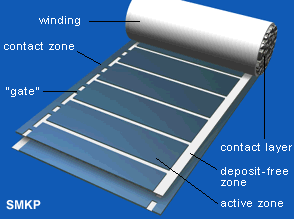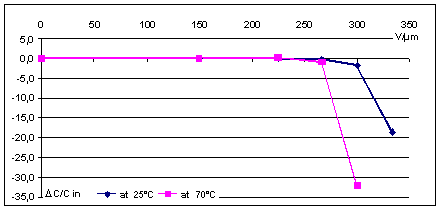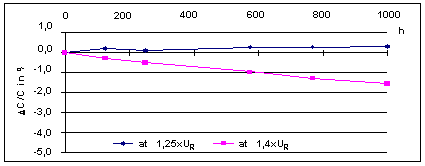Product information
Studies on the voltage strength of the SMKP dielectric
In recent years an increasing number of MKP capacitors have been manufactured for dc applications,
utilizing a special segmented coating. These are used as intermediate circuit, reservoir, or filter
capacitors. As a consequence of the high field strength which is possible in these capacitors, they
show a very high specific capacitance.
|
Figure 1 shows the schematic structure of this dielectric, which we at
ELECTRONICON have called "SMKP" (from the German
"Segment-metallisierter Kunststoffkondensator, Polypropylen":
plastic capacitor, polypropylene, with segmented metal coating).
Apart from the well-known self-healing effect in which the thin metal coating only several
nanometers thick around a dielectric breakdown spot is evaporated, insulating the defect, the
dielectric shows an additional fuse characteristic in the shape of so-called "current gates".
In the event of a non-self-healing breakdown, these gates, which are unable to withstand the
rising current to the fault, are vapourized and disconnect the affected sector completely.
Figure 1 - structure of an SMKP dielectric
|

|
 Figure 2 shows the results of a voltage test in short term operation. The test voltage was applied
for 10 minutes at each marked field strength level, after which the capacitance was measured. One
can see that at an operating field strength of approx. 150V/Ám and a test field strength of 225V/Ám,
no changes in the dielectric can be detected at all. Conversely, when tested at an increased ambient
temperature,significant loss of capacitance is evident even at lower field strength levels.
Figure 2 shows the results of a voltage test in short term operation. The test voltage was applied
for 10 minutes at each marked field strength level, after which the capacitance was measured. One
can see that at an operating field strength of approx. 150V/Ám and a test field strength of 225V/Ám,
no changes in the dielectric can be detected at all. Conversely, when tested at an increased ambient
temperature,significant loss of capacitance is evident even at lower field strength levels.
pic.2 - short term test of the dielectric strength
However, the test demonstrated in Figure 2 is not sufficient to evaluate the behaviour of SMKP capacitors in continuous operation.
According to IEC EN61071 (IEC 1071) capacitors should be designed to withstand the following overvoltages during operation:
| 1.1 x UR |
30 % of the duty cycle |
| 1.15 x UR |
30 min/day |
| 1.2 x UR |
5 min/day |
| 1.3 x UR |
1 min/day |
| 1.5 x UR |
100 ms/day |
Compliance with this specification is shown with an accelerated ageing test. The capacitors are
discharged 1000 times at twice their permitted peak current, and then exposed to a permanent voltage
of 1.4 x UR at upper category temperature. During this test, the capacitance must drop by no more
than 2%.
Figure 3 demonstrates the behaviour of these capacitors during the ageing test.
The capacitors were

- exposed to an overvoltage of 1.25 x UR for the duration of 1000hrs. This meets the ageing test requirements of part 12 of the old standard VDE 0560.
- 2. afterwards taken to 1.4 x UR for 1000 hrs. It should be noted at this point that IEC EN61071 (which conforms to IEC1071/VDE 0560 part 120/121) only requires a test period of 500hrs.
Figure 3 -capacitance drift during ageing test.
The IEC standard requires that an overvoltage of 1.3 x UR be applicable for one minute per day.
Given an operation period of 100,000 hours this would correspond to a total load of 70 hours at
1.3 x UR. This demonstrates the high requirements of the type tests of capacitors and
that high safety margins are necessary.
Traction applications tend to have much higher requirements regarding the magnitude and duration of
overvoltages. Figure 4 demonstrates the results of a test which reproduced a 15sec overvoltage of
1.2 x UR every 15 minutes. In other words, a situation where this overvoltage would last 24 minutes
per day instead of the 5 minutes permitted by IEC was simulated. This test was carried out for 1000
cycles.
Graph 2 shows the capacitance drift of the capacitor tested at the upper category temperature of
75°C required by the customer, while graph 1 shows the same overvoltage load at a temperature of
approx. 30°C.
It can be seen that overvoltages which may not be critical at room temperature can lead to noticeable loss of capacitance at higher operating temperatures.
 Figure 4 - test of dielectric strength
Figure 4 - test of dielectric strength
Conclusions
The SMKP-dielectric has a high dielectric strength and can be exposed to the overvoltages specified
in IEC EN61071 at ambient temperatures of up to 70°C.
In order to ensure a long service life for the capacitor, operation at the upper temperature
limit should be avoided where possible. If the application demands very high dielectric strength,
possible solutions could include the reduction of the upper limit of the operating temperature, or
reduction of the operating field strength, achieved through changes in the capacitor's construction.
However, at lower ambient temperatures, up to 506deg;C, the SMKP dielectric has high reserves of
overvoltage capability.
Home

 Figure 2 shows the results of a voltage test in short term operation. The test voltage was applied
for 10 minutes at each marked field strength level, after which the capacitance was measured. One
can see that at an operating field strength of approx. 150V/Ám and a test field strength of 225V/Ám,
no changes in the dielectric can be detected at all. Conversely, when tested at an increased ambient
temperature,significant loss of capacitance is evident even at lower field strength levels.
Figure 2 shows the results of a voltage test in short term operation. The test voltage was applied
for 10 minutes at each marked field strength level, after which the capacitance was measured. One
can see that at an operating field strength of approx. 150V/Ám and a test field strength of 225V/Ám,
no changes in the dielectric can be detected at all. Conversely, when tested at an increased ambient
temperature,significant loss of capacitance is evident even at lower field strength levels.

 Figure 4 - test of dielectric strength
Figure 4 - test of dielectric strength